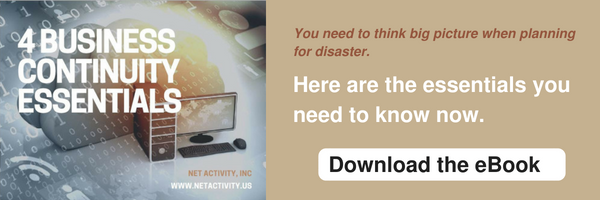5 Types of Disasters You Don’t See Coming That Can Hinder Your Business Continuity
Only 6% of companies without a disaster recovery plan survive a disaster.
When computer systems fail, or disaster strikes, business comes to a grinding halt. Replacement hardware takes time to order and install, infrastructure needs to be rebuilt, and backups need to be prepared and applied. This can take days or weeks, even with a good backup solution. Unfortunately, when business is down, every second counts.
Business continuity is a term that describes your capability to continue to deliver products or services following a disruptive incident. But, business continuity planning can be an afterthought until cyber theft or a natural disaster occurs and all systems come to a halt. Small business (non-IT or non-technical businesses) can prepare for business continuity by planning for the following 5 disasters:
Not “Planning to Fail.”
Machines and hardware fail. Machines and hardware fail. While most IT hardware is fairly resistant to failures, most devices fall far short of a perfect track record, and no one is immune to hard disk or internet connection failures. While it can be costly for your company to eliminate any single point of failure in your IT infrastructure, having a disaster recovery plan that does this is the only way to ensure that a hardware failure doesn’t interrupt your service or cause data loss.
Failing to Plan.
Only 6% of companies without a disaster recovery plan survive a disaster. When something goes wrong- whether it’s a natural disaster such as flood or fire, a criminal attack like a burglary or cybercrime, or human error causing a system failure or other incident – you need more than insurance policies to protect your business. Disaster Recovery and Business Continuity Planning (DRBC) is your first line of defense when an incident occurs. While insurance companies sort out claims, it needs to be ‘business as usual’ for most companies, and there’s no time to wait for paperwork to be completed and this is where your disaster recovery and business continuity planning are vital.
Understanding that IT Disasters are Costly.
The costs associated with not preparing for an IT disaster are staggering; and many companies that aren’t effectively prepared for disaster situations simply cannot bounce back from a significant crisis. In fact, up to 75 percent of businesses fail within three years after a major natural or data disaster. The good news is that research shows companies with business continuity planning recover faster and more effectively following an emergency. In the meantime, the expected cost of data breaches and data loss will top $2.1 trillion by 2019 as more data is digitized, and the majority of these data breaches will come from existing network infrastructure and IT systems.
Remembering that Humans Make Mistakes; and Preparing for It.
80% of downtime instances impact mission-critical applications and business data and the majority are caused by human error. Human error is, by far, the most common and most frequent cause of business disasters. By definition, human errors are unintentional but can often be the hardest to prevent and correct. Having a disaster recovery plan that creates a series of incremental online data backups lets you easily restore your files to an error-free state. A disaster recovery plan that incorporates checking and double checking, along with online backups is often the best remedy.
Disasters affect everything.
Your business runs 365 days a year; your systems run 24/7; your data is needed in real-time. A data center outage costs about $8851 per minute and can cause forfeited sales, lost data, damaged equipment, disrupted processes, legal or compliance liabilities, damaged client relationships and reputation, and wasted resources controlling the damage.
Businesses with a disaster recovery plan report increased savings, enhanced system reliability, improved security and reduced insurance premiums…even without a disaster. It’s important for you-as a business owner, office manager or CEO to remember: “the time to prepare the roof is while the sun is still shining.” (Kennedy)






